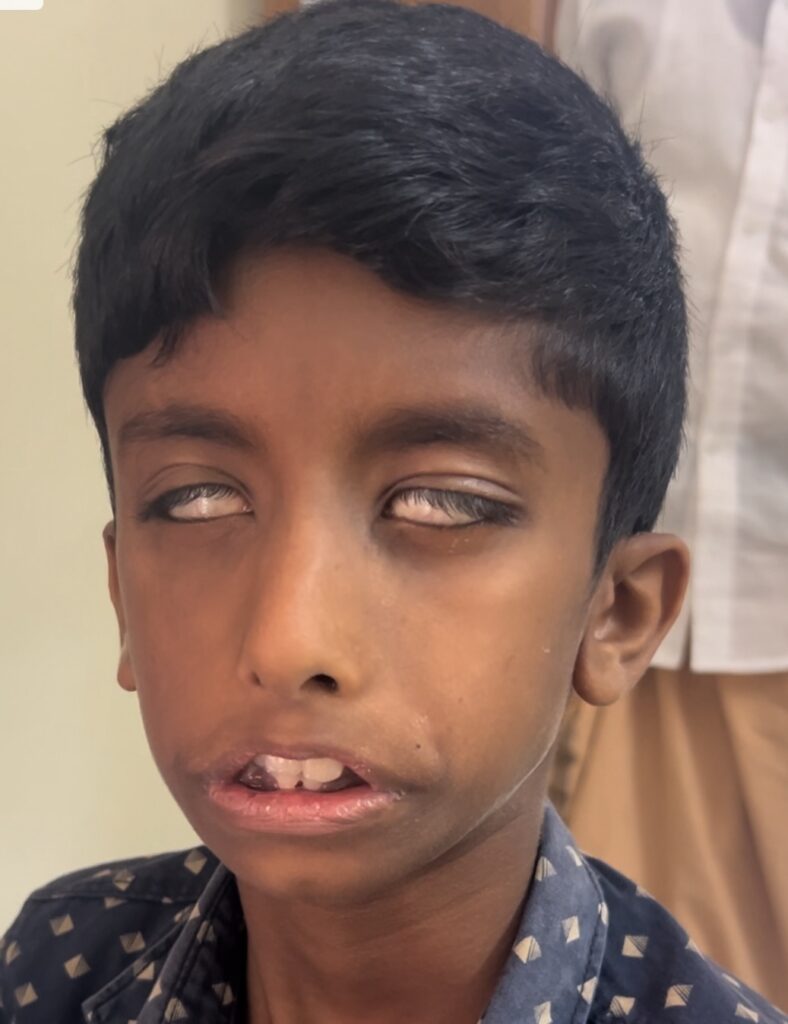Dr.Ch. Venkat Kumar Raju, Dr.C Jayakumar
Department of pediatrics
8yr old child was brought to a tribal outreach camp with complaints of lack of facial expressions since birth. He has never been evaluated or examined before. On probing he had difficulty in closure of eyes during sleep. He was born 1st of non-consanguineous marriage normal vaginal delivery with a birth weight of 2.6kg. Developmentally he had
significant gross and fine motor delay. But he has difficulty in language and mathematics.
On examining the child, he was alert active. No PICCLE, on CNS examination he has no facial creases, no forehead wrinkles, no nasolabial folds. And there is upward movement of the front of the eyelids when the eyelids close
At this point out D/Ds were
1. Congenital facial nerve palsy
2. Congenital Myopathies
3. Poland syndrome


As shown in the pictures he has keratoconus and bilateral LMN type facial palsy with bells phenomenon
Moebius syndrome was considered in view of symptoms dating from birth.
Parents were counselled regarding the child’s condition and the need of physiotherapy and occupational therapy. Most cases of Moebius syndrome occur randomly for unknown reasons (sporadically) in the absence of a family history of the disorder. The syndrome is listed as Online Mendelian Inheritance in Man (OMIM) Number 15700, with a gene map locus of 13q12.2-q13. Sporadicmutations in PLXND1 and REV3L genes have also been identified in a number of patients and
confirmed to cause a constellation of findings consistent with Moebius syndrome when introduced in animal models. In rare cases, familial patterns have been reported. Most likely, Moebius syndrome ismultifactorial, which means that both genetic and environmental factors play some causative role. It is possible that in different cases there are different underlying causes (heterogeneity).In familial cases, there is evidence that Moebius syndrome is inherited as an autosomal dominant trait. Dominant genetic disorders occur when only a single copy of an abnormal
gene is necessary for the appearance of the disease. The abnormal gene can be inherited from either parent or can be the result of a new mutation (gene change) in the affected individual. The risk of passing the abnormal gene from affected parent to offspring is 50% for each pregnancy regardless of the sex of the resulting child.
The treatment of Moebius syndrome is directed toward the specific abnormalities in each
individual. Usually these children are managed a multidisciplinary team, often in a
craniofacial center. Involved specialists include: pediatricians; neurologists; plastic surgeons;
ear, nose, and throat specialists (otolaryngologists); orthopedists; dental specialists; speech
pathologists; specialists who assess and treat hearing problems (audiologists), specialists
who treat eye abnormalities (ophthalmologists) and other healthcare professionals.
Corrective procedures for facial paralysis involve transfer of muscle and/or graft nerves from
another area of the face or the body. An old procedure, known as temporalis tendon transfer,
involves taking the temporalis muscle, one of the muscles normally used for chewing
(mastication), and transferring it to the corners of the mouth. This same type of operation can
be also used to improve closure of the eyelids. If the paralysis is on only one side (unilateral), a “cross-facial nerve graft” is an option. The procedure involves taking a sensory nerve from the calf, attaching it to a branch of the functioning facial nerve on the normal side of the face and then waiting until the regenerating nerve fibers cross over the face to reach the paralyzed
side where it is joined to a motor nerve of a thin muscle transferred to the face microvascular anastomosis.
Take home message- When we see a bilateral LMN type facial nerve palsy always think of Moebius, an early diagnosis and multidisciplinary management can greatly enhance quality of life for affected individuals.
